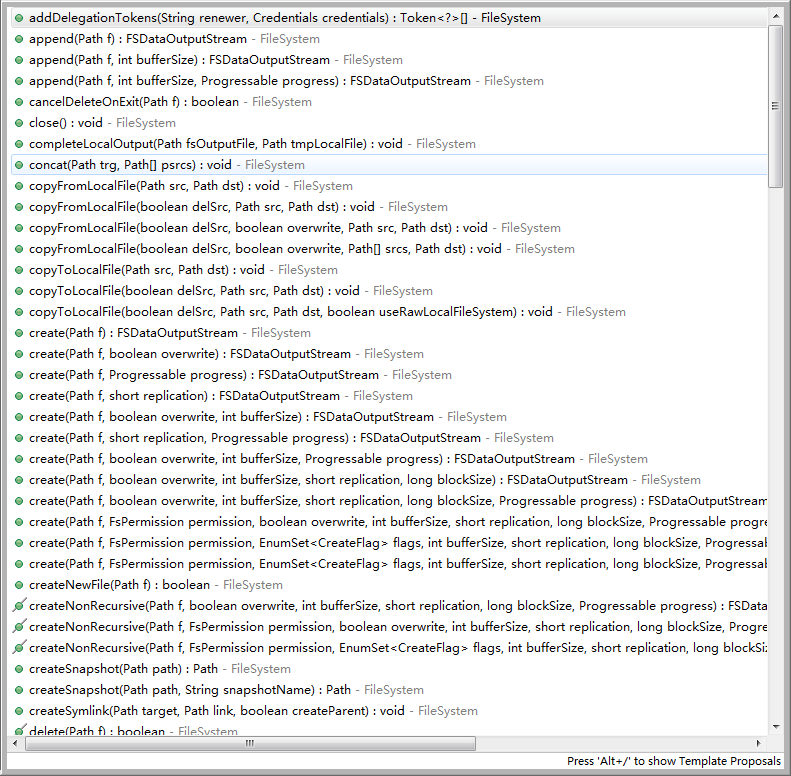首页 > 代码库 > HDFS应用开发篇
HDFS应用开发篇
HDFS的java操作
hdfs在生产应用中主要是客户端的开发,其核心步骤是从hdfs提供的api中构造一个HDFS的访问客户端对象,然后通过该客户端对象操作(增删改查)HDFS上的文件
7.1 搭建开发环境
1、引入依赖
|
注:如需手动引入jar包,hdfs的jar包----hadoop的安装目录的share下
2、window下开发的说明
建议在linux下进行hadoop应用的开发,不会存在兼容性问题。如在window上做客户端应用开发,需要设置以下环境:
A、在windows的某个目录下解压一个hadoop的安装包
B、将安装包下的lib和bin目录用对应windows版本平台编译的本地库替换
C、在window系统中配置HADOOP_HOME指向你解压的安装包
D、在windows系统的path变量中加入hadoop的bin目录
7.2 获取api中的客户端对象
在java中操作hdfs,首先要获得一个客户端实例
Configuration conf = new Configuration() FileSystem fs = FileSystem.get(conf) |
而我们的操作目标是HDFS,所以获取到的fs对象应该是DistributedFileSystem的实例;
get方法是从何处判断具体实例化那种客户端类呢?
——从conf中的一个参数 fs.defaultFS的配置值判断;
如果我们的代码中没有指定fs.defaultFS,并且工程classpath下也没有给定相应的配置,conf中的默认值就来自于hadoop的jar包中的core-default.xml,默认值为: file:///,则获取的将不是一个DistributedFileSystem的实例,而是一个本地文件系统的客户端对象
7.3 DistributedFileSystem实例对象所具备的方法

7.4 HDFS客户端操作数据代码示例:
hdfs dfsadmin -report查看状态
7.4.1 文件的增删改查
public class HdfsClient {
FileSystem fs = null;
@Before public void init() throws Exception {
// 构造一个配置参数对象,设置一个参数:我们要访问的hdfs的URI // 从而FileSystem.get()方法就知道应该是去构造一个访问hdfs文件系统的客户端,以及hdfs的访问地址 // new Configuration();的时候,它就会去加载jar包中的hdfs-default.xml // 然后再加载classpath下的hdfs-site.xml Configuration conf = new Configuration(); conf.set("fs.defaultFS", "hdfs://hdp-node01:9000"); /** * 参数优先级: 1、客户端代码中设置的值 2、classpath下的用户自定义配置文件 3、然后是服务器的默认配置 */ conf.set("dfs.replication", "3");
// 获取一个hdfs的访问客户端,根据参数,这个实例应该是DistributedFileSystem的实例 // fs = FileSystem.get(conf);
// 如果这样去获取,那conf里面就可以不要配"fs.defaultFS"参数,而且,这个客户端的身份标识已经是hadoop用户 fs = FileSystem.get(new URI("hdfs://hdp-node01:9000"), conf, "hadoop");
}
/** * 往hdfs上传文件 * * @throws Exception */ @Test public void testAddFileToHdfs() throws Exception {
// 要上传的文件所在的本地路径 Path src = http://www.mamicode.com/new Path("g:/redis-recommend.zip"); // 要上传到hdfs的目标路径 Path dst = new Path("/aaa"); fs.copyFromLocalFile(src, dst); fs.close(); }
/** * 从hdfs中复制文件到本地文件系统 * * @throws IOException * @throws IllegalArgumentException */ @Test public void testDownloadFileToLocal() throws IllegalArgumentException, IOException { fs.copyToLocalFile(new Path("/jdk-7u65-linux-i586.tar.gz"), new Path("d:/")); fs.close(); }
@Test public void testMkdirAndDeleteAndRename() throws IllegalArgumentException, IOException {
// 创建目录 fs.mkdirs(new Path("/a1/b1/c1"));
// 删除文件夹 ,如果是非空文件夹,参数2必须给值true fs.delete(new Path("/aaa"), true);
// 重命名文件或文件夹 fs.rename(new Path("/a1"), new Path("/a2"));
}
/** * 查看目录信息,只显示文件 * * @throws IOException * @throws IllegalArgumentException * @throws FileNotFoundException */ @Test public void testListFiles() throws FileNotFoundException, IllegalArgumentException, IOException {
// 思考:为什么返回迭代器,而不是List之类的容器 RemoteIterator<LocatedFileStatus> listFiles = fs.listFiles(new Path("/"), true);
while (listFiles.hasNext()) { LocatedFileStatus fileStatus = listFiles.next(); System.out.println(fileStatus.getPath().getName()); System.out.println(fileStatus.getBlockSize()); System.out.println(fileStatus.getPermission()); System.out.println(fileStatus.getLen()); BlockLocation[] blockLocations = fileStatus.getBlockLocations(); for (BlockLocation bl : blockLocations) { System.out.println("block-length:" + bl.getLength() + "--" + "block-offset:" + bl.getOffset()); String[] hosts = bl.getHosts(); for (String host : hosts) { System.out.println(host); } } System.out.println("--------------为angelababy打印的分割线--------------"); } }
/** * 查看文件及文件夹信息 * * @throws IOException * @throws IllegalArgumentException * @throws FileNotFoundException */ @Test public void testListAll() throws FileNotFoundException, IllegalArgumentException, IOException {
FileStatus[] listStatus = fs.listStatus(new Path("/"));
String flag = "d-- "; for (FileStatus fstatus : listStatus) { if (fstatus.isFile()) flag = "f-- "; System.out.println(flag + fstatus.getPath().getName()); } } } |
7.4.2 通过流的方式访问hdfs
/** * 相对那些封装好的方法而言的更底层一些的操作方式 * 上层那些mapreduce spark等运算框架,去hdfs中获取数据的时候,就是调的这种底层的api * @author * */ public class StreamAccess { FileSystem fs = null;
@Before public void init() throws Exception {
Configuration conf = new Configuration(); fs = FileSystem.get(new URI("hdfs://hdp-node01:9000"), conf, "hadoop");
} @Test public void testDownLoadFileToLocal() throws IllegalArgumentException, IOException{ //先获取一个文件的输入流----针对hdfs上的 FSDataInputStream in = fs.open(new Path("/jdk-7u65-linux-i586.tar.gz")); //再构造一个文件的输出流----针对本地的 FileOutputStream out = new FileOutputStream(new File("c:/jdk.tar.gz")); //再将输入流中数据传输到输出流 IOUtils.copyBytes(in, out, 4096); } /** * hdfs支持随机定位进行文件读取,而且可以方便地读取指定长度 * 用于上层分布式运算框架并发处理数据 * @throws IllegalArgumentException * @throws IOException */ @Test public void testRandomAccess() throws IllegalArgumentException, IOException{ //先获取一个文件的输入流----针对hdfs上的 FSDataInputStream in = fs.open(new Path("/iloveyou.txt")); //可以将流的起始偏移量进行自定义 in.seek(22); //再构造一个文件的输出流----针对本地的 FileOutputStream out = new FileOutputStream(new File("c:/iloveyou.line.2.txt")); IOUtils.copyBytes(in,out,19L,true); } /** * 显示hdfs上文件的内容 * @throws IOException * @throws IllegalArgumentException */ @Test public void testCat() throws IllegalArgumentException, IOException{ FSDataInputStream in = fs.open(new Path("/iloveyou.txt")); IOUtils.copyBytes(in, System.out, 1024); } } |
7.4.3 场景编程
在mapreduce 、spark等运算框架中,有一个核心思想就是将运算移往数据,或者说,就是要在并发计算中尽可能让运算本地化,这就需要获取数据所在位置的信息并进行相应范围读取
以下模拟实现:获取一个文件的所有block位置信息,然后读取指定block中的内容
@Test public void testCat() throws IllegalArgumentException, IOException{ FSDataInputStream in = fs.open(new Path("/weblog/input/access.log.10")); //拿到文件信息 FileStatus[] listStatus = fs.listStatus(new Path("/weblog/input/access.log.10")); //获取这个文件的所有block的信息 BlockLocation[] fileBlockLocations = fs.getFileBlockLocations(listStatus[0], 0L, listStatus[0].getLen()); //第一个block的长度 long length = fileBlockLocations[0].getLength(); //第一个block的起始偏移量 long offset = fileBlockLocations[0].getOffset(); System.out.println(length); System.out.println(offset); //获取第一个block写入输出流 //IOUtils.copyBytes(in, System.out, (int)length); byte[] b = new byte[4096]; FileOutputStream os = new FileOutputStream(new File("d:/block0")); while(in.read(offset, b, 0, 4096)!=-1){ os.write(b); offset += 4096; if(offset>=length) return; }; os.flush(); os.close(); in.close(); } |
本文出自 “上善若水” 博客,请务必保留此出处http://yushiwh.blog.51cto.com/2911795/1912405
HDFS应用开发篇
